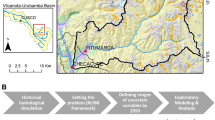Abstract
The sustainability index (SI) is a relatively new concept for measuring the performance of water resource systems over long time periods. Its definition is aimed at providing an indication of the integral behaviour of the system with regards to possible undesired consequences if misbalance of available and required waters occurs. SI is initially defined as a product and later reformulated as a geometric mean of performance indicators: reliability, resilience and vulnerability. As an extension of a recently published methodology to compute and use SI, in this paper we propose introducing two more indicators of system performance: (1) reliability of annual firm (safe) water as a system yield and (2) deviation of reservoir levels from corresponding rule curves. The last indicator is of particular importance if there are multi-purpose reservoirs in the system because reservoirs are the most important and sensitive regulators of the water regime within the system. We also propose a framework for assessing system performance in a systematic manner to compute SI at various locations within the system if different operating strategies are applied and, finally, how to evaluate strategies according to the resulting SI by using multi-criteria methods. A case study example from Serbia is used to illustrate the results of measuring sustainability under alternative operating scenarios for a system with three reservoirs and two diversion structures.





Similar content being viewed by others
References
Abazaj J, Ruud A, Moen Ø (2016) Ambitious goals and ambiguous issues: integrating water and energy concerns in the Norwegian hydropower sector. Water Util J 12:3–15
Aversa IC, Brandao JLB (2014) Performance evaluation of a river basin committee in Brazil. Eur Water 45:35–44
Butler D, Farmani R, Fu G, Ward S, Diao K, Astaraie-Imani M (2014) A new approach to urban water management: safe and SuRe. 16th conference on water distribution system analysis, WDSA 2014. Elsevier, Bari
Butler, D., Ward, S., Sweetapple, C., Astaraie-Imani, M., Diao, K., Farmani, R., and Fu, G. (2016). Reliable, resilient and sustainable water management: the safe & SuRe approach. Global Challenges, doi:10.1002/gch2.1010.
Cai X, McKinney DC, Lasdon LS (2002) A framework for sustainability analysis in water resources management and application to the Syr Darya basin. Water Resour Res 38(6):1085–1098
Delft Hydraulics Institute (2016) Myke Hydro Basin - River basin planning and management simulation program. https://www.mikepoweredbydhi.com/products/mike-hydro-basin
Fiering MB (1967) Stream flow synthesis. Harvard University Press, Cambridge
Hashimoto T. (1980). Robustness, reliability, resilience and vulnerability criteria for water resources planning. Ph.D. dissertation, Cornel Univ., Ithaca
Hashimoto T, Stedinger JR, Loucks DP (1982) Reliability, resiliency and vulnerability criteria for water resource system performance evaluation. Water Resour Res 18(1):14–20
Hirsch RM (1979) Synthetic hydrology and water supply reliability. Water Resour Res 15(6):1603–1615
Hwang CL, Yoon KS (1981) Multiple attribute decision making: methods and applications. Springer, Berlin
Karavitis CA, Vasilakou CG, Tsesmelis DE, Oikonomou PD, Skondras NA, Stamatakos D, Fassouli V, Alexandris S (2015) Short-term drought forecasting combining stochastic and geo-statistical approaches. Eur Water 49:43–63
Labadie JW. (2000). MODSIM - decision support system for integrated river basin management. Documentation and User Manual, Colorado State University, Fort Collins
Loucks DP (1997) Quantifying trends in system sustainability. Hydrol Sci J 42(4):513–530
Loucks DP, van Beek E. (2005). Water resources systems planning and management. United Nations Educational, Scientific and Cultural Organization (UNESCO), Paris
Maestro MT, Nicolosi V, Cancelliere A, Bielza M (2014) Impacts of climate change, hydrological drought mitigation measures and irrigation demand on water supply system performance. Eur Water 45(46):25–33
Matalas NC (1967) Mathematical assessment of of synthetic hydrology. Water Resour Res 3(4):937–945
McMahon TA, Adeloye AJ, Sen-Lin Z (2006) Understanding performance measures of reservoirs. J Hydrol 324:359–382
Mendoza VM, Villanuave EE, Adem J (1997) Vulnerability of basins and watersheds in Mexico to global climate change. Clim Res 9:139–145
MODSIM (2014). http://modsim.engr.colostate.edu/
Moy WS, Cohon JL, Revelle CS (1986) A programming model for analysis of reliability, resilience and vulnerability of a water supply reservoir. Water Resour Res 22(4):489–498
Sandoval-Solis S, McKinney DC, Loucks DP (2011) Sustainability index for water resources planning and management. Water Resour Plan Manag 2011:381–390
SEI Stockholm Environment Institute (2005). WEAP: water evaluation and planning system. User Guide. Somerville
Soundharajan BS, Adeloye AJ, Remesan R (2016) Evaluating the variability in surface water reservoir planning characteristics during climate change impacts assessment. J Hydrol 538:625–639
Srdjevic B. (1987). Identification of the control strategies in water resources systems with reservoirs by use of network models., Ph. Dissertation, Univ. of Novi Sad, Serbia.
Srdjevic B, Srdjevic Z. (2016): Water resources systems analysis with extensions in water management. Faculty of Agriculture Novi Sad (p. 321) (in Serbian)
TWDB (1972). SIMYLD-II River basin simulation model, Texas Water Development Board. Austin
World Health Organization (WHO) (2009). Summary and policy implications - vision 2030: The resilience of water supply and sanitation in the face of climate change, Geneva
Young GK, Pisano WC. (1968). Operating hydrology using residuals. J Hydraul Div 94:909–924
Zeleny M (1982) Multiple criteria decision making. McGraw Hill, New York
Acknowledgements
This work was supported in part by Ministry of Education, Science and Technological Development of Serbia under the grant 174003 (2011-2016) - Theory and application of Analytic hierarchy process (AHP) in multi-criteria decision making under conditions of risk and uncertainty (individual and group context).
Author information
Authors and Affiliations
Corresponding author
Rights and permissions
About this article
Cite this article
Srdjevic, Z., Srdjevic, B. An Extension of the Sustainability Index Definition in Water Resources Planning and Management. Water Resour Manage 31, 1695–1712 (2017). https://doi.org/10.1007/s11269-017-1609-6
Received:
Accepted:
Published:
Issue Date:
DOI: https://doi.org/10.1007/s11269-017-1609-6




